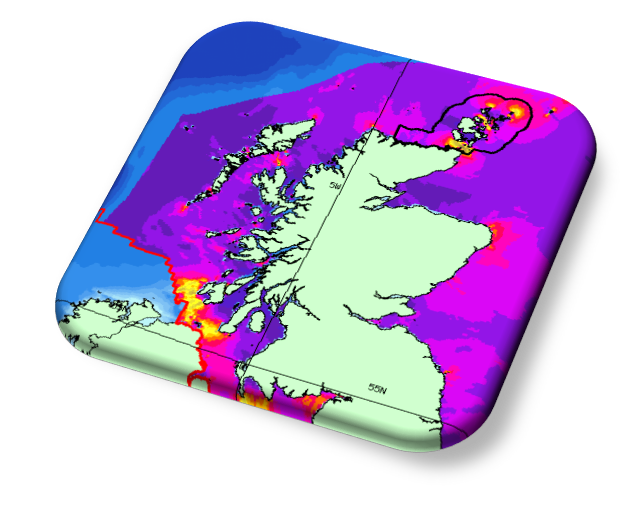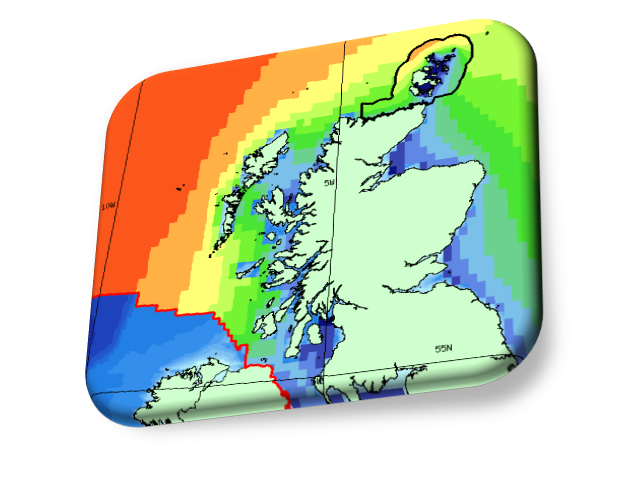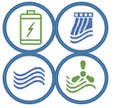The initial assessment phase of the process is centred around data gathering and establishing a comprehensive understanding of the specific situation which is under consideration, this involves the use of a variety of publicly available data sources and use of knowledge of existing grid infrastructure. As a crucial step at the onset of any evaluation, this stage in the process identifies areas which are useful, or not, and is essentially a very broad scoping study, this aids in the elimination of options which would ultimately not be viable and represent wasted effort.
Infrastructure
In order to determine the suitability of certain resource locations and extraction methods, it is important to be aware of the limitations of the current grid infrastructure. This may restrict the magnitude of device which is installed or determine remote locations as overly cost intensive for use due to the requirement for extensive civil works to connect the generator to the distribution network. Typically this information will be known by those who endeavour to use the tool, ideally community trusts, given that a certain degree of technical sophistication or past experience would be expected of those in ownership of their electricity network and seeking to modify its capacity.
Site Identification
Important factors in the establishment of sites to be considered for resource assessment are the geographical layout of the subsea terrain, or bathymetry, and also the magnitude of wave height and frequency or tidal range and flow rates. This information is crucial to the assessment of potential resources and is available from a range of sources.
Bathymetry
Data regarding the seabed is not required to be overly detailed at this stage of any resource assessment and serves as a measure of establishing whether there exits sufficient water depth for devices, or there are explicit obstacles to deployment such as overly steep gradients. This data is readily available from navigational charts for the area.
Tidal and Wave Resource Assessment
Perhaps the most crucial information which is required prior to resource assessment is that specific to the type of energy which is being assessed. Tidal devices, both range and stream, require:
Peak flow rates are used to identify the maximum kinetic energy which can be extracted form the site, and in conjunction with the monthly tidal profile, this can be transformed into a time dependent velocity profile over the course of a typical lunar tidal cycle. This data can be extended over the course of one year to give an annual energy prediction. Tidal Range devices are simpler to quantify as they operate under the principle of potential energy difference between two bodies of water separate by a barrier, with regard to this, the required data is simply the tidal period and averaged maximum and minimum tide heights over the course of the time period in question.
Wave resource calculations rely on a combination of wave period (T) and significant wave height (Hs) to calculate the available power during various sea conditions. The overall availability can be calculated by summing the probability of the optimum operating conditions for each device and this is applied to rated power to attain a relevant output.
Our resource calculations should give and indication of the premium areas of interest but an indepth analysis should be performed.
It would be recommended that an annual wave buoy be deployed to ascertain:
The depth is particularly important as waves tend to increase in power as they reach shallower water. This will indicate the general sea conditions and the suitability of each device for each location but also indicate cost of potential grid connection.
Additionally, given the geography of the area under consideration, onshore and offshore locations may be considered for the application of physical means of energy storage. Pumped hydro storage and compressed air storage systems are reliant upon the availability of suitable terrain and it is possible to scope such methods in or out at this stage based on an overview of the area. The gathered data is then input into the advisory tool at the 'Input' page of the excel workbook within which it is contained.
Infrastructure
In order to determine the suitability of certain resource locations and extraction methods, it is important to be aware of the limitations of the current grid infrastructure. This may restrict the magnitude of device which is installed or determine remote locations as overly cost intensive for use due to the requirement for extensive civil works to connect the generator to the distribution network. Typically this information will be known by those who endeavour to use the tool, ideally community trusts, given that a certain degree of technical sophistication or past experience would be expected of those in ownership of their electricity network and seeking to modify its capacity.
Site Identification
Important factors in the establishment of sites to be considered for resource assessment are the geographical layout of the subsea terrain, or bathymetry, and also the magnitude of wave height and frequency or tidal range and flow rates. This information is crucial to the assessment of potential resources and is available from a range of sources.
Bathymetry
Data regarding the seabed is not required to be overly detailed at this stage of any resource assessment and serves as a measure of establishing whether there exits sufficient water depth for devices, or there are explicit obstacles to deployment such as overly steep gradients. This data is readily available from navigational charts for the area.
Tidal and Wave Resource Assessment
Perhaps the most crucial information which is required prior to resource assessment is that specific to the type of energy which is being assessed. Tidal devices, both range and stream, require:
- Peak Tidal Flow Rate – Spring Tides
- Peak Tidal Flow Rate – Neap Tides
- Monthly Tidal Profile
Peak flow rates are used to identify the maximum kinetic energy which can be extracted form the site, and in conjunction with the monthly tidal profile, this can be transformed into a time dependent velocity profile over the course of a typical lunar tidal cycle. This data can be extended over the course of one year to give an annual energy prediction. Tidal Range devices are simpler to quantify as they operate under the principle of potential energy difference between two bodies of water separate by a barrier, with regard to this, the required data is simply the tidal period and averaged maximum and minimum tide heights over the course of the time period in question.
Wave resource calculations rely on a combination of wave period (T) and significant wave height (Hs) to calculate the available power during various sea conditions. The overall availability can be calculated by summing the probability of the optimum operating conditions for each device and this is applied to rated power to attain a relevant output.
Our resource calculations should give and indication of the premium areas of interest but an indepth analysis should be performed.
It would be recommended that an annual wave buoy be deployed to ascertain:
- The range of significant wave heights (Hs) and preferably the annual probability.
- The range of significant wave period (T) and preferably the annual probability.
- The range of significant wave length (λ) and preferably the annual probability.
- The water depth at the proposed site.
The depth is particularly important as waves tend to increase in power as they reach shallower water. This will indicate the general sea conditions and the suitability of each device for each location but also indicate cost of potential grid connection.
Additionally, given the geography of the area under consideration, onshore and offshore locations may be considered for the application of physical means of energy storage. Pumped hydro storage and compressed air storage systems are reliant upon the availability of suitable terrain and it is possible to scope such methods in or out at this stage based on an overview of the area. The gathered data is then input into the advisory tool at the 'Input' page of the excel workbook within which it is contained.
Finally, at this stage, a decision is made as to whether it would be best to adopt a strategy of installing additional generation or storage capacity. Should there be an substantial, existing excess of energy generation, and no grid connected means of energy export, it would be most prudent to consider storage as the preferred option, however, should a community wish to expand rather than simply live within their existing limitations, additional generation may be most beneficial. As this determination is partially subjective,and reliant on the community intentions, the tool will return both options at the final stages and the decision is made manually.



